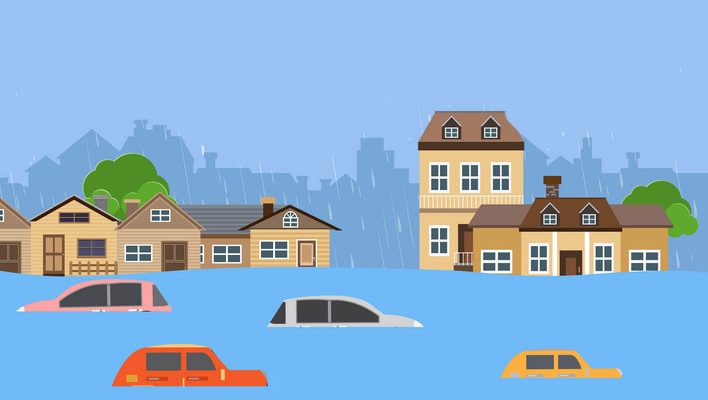
06-10-2023 (Important News Clippings)
To Download Click Here.
 Date:06-10-23
Date:06-10-23
SOS From Mountains
Loss of life and infra in Sikkim flash floods is another reminder of project risks in Himalayas.
TOI Editorials

We know all this, but India lives in post-event damage-control mode. Sikkim’s disaster committeehad flagged a vulnerability a decade ago for Lhonak Lake, the very site of Wednesday’s GLOF event. It wasn’t the only report or study. Each Himalayan state is battling consequences of a state-and-public disdain, time and again, for scientific caution, vulnerability mapping and ecological risks of construction in hill states alongside climate impact. This includes warnings against large hydro projects on terrains established as being geologically unstable.
The losses in Uttarakhand, Himachal and now Sikkim have much to do with a wink-and-nudge policy framework that bypasses environmental concerns to build in the mountains. It is precisely due to the doubtful resilience of such construction that many projects get mired in long delays and overrun costs. Climate change risks are barely accounted for, triggering cascading hazard chains that simply get amplified downstream. After Sikkim, there are flood alerts for Bengal and Bangladesh. The Himalayas are frequently flashing SOS signs of unsustainable operations. What scale of tragedy will it take for policymakers to sit up?
Equality and identity
Equitable distribution of resources must not be by accentuating caste identity.
Editorial
The significance of Bihar conducting a caste survey and publishing a caste-wise count of its population is quite immense. The survey, which had all the trappings of a census, complete with a two-stage process of house-listing followed by the eliciting of information from the households, has shown that 63% of Bihar’s 13 crore population belong to castes listed under the Extremely Backward Classes (EBC) and Other Backward Classes (OBC) categories. The socio-economic profiles of the people have also been recorded, but are yet to be revealed. At the national level, it may give a boost to the political demand for a country-wide caste census and push the judicial discourse towards reconsidering the 50% legal ceiling on total reservation in education and government services. In terms of party politics, it may open a new chapter in the traditional conflict between the BJP seeking to consolidate all sections of Hindus into one massive support base and other parties banking on different sections of the OBCs. At a time when Hindutva is seen to have trumped parties that banked on OBC assertion, influential social groups may now sense an opportunity to leverage their size to get their interests advanced by the political class. On the legal side, the numbers may be utilised to present the sort of ‘quantifiable data’ that the judiciary has been asking for to justify the levels of reservation obtaining in various States.
Bihar’s exercise marks a precedent on how a caste count should be conducted. The methodology included giving a code to each of the 214 castes in the State’s lists of castes. Sub-castes and sects were identified in advance and subsumed under a broader caste name. This meant that the enumerators could assign a code to any caste name given by a respondent. A major reason for the Union government not releasing the caste-related details of its 2011 ‘Socio-economic and Caste Census’ was that the data it yielded was too confusing and unwieldy. As many as 46 lakh castes were named by the people, presumably because they gave castes, sub-castes, sects, clans, and surnames when asked to name their castes. While there are functional and practical advantages to knowing exact caste numbers, it is not to be forgotten that the larger goal of the Constitution remains the attainment of a casteless society. Affirmative action indeed helps address inequities in society. The state must also look for ways to ensure equality of opportunity and equitable distribution of resources without accentuating caste identity.
कानून नहीं पुरुषों का नारी के प्रति नजरिया बदलना होगा
संपादकीय

सिक्किम के सबक
संपादकीय
उत्तरी सिक्किम में तीस्ता नदी में अचानक बाढ़ आने से मची तबाही चिंतित करने वाली है। वहां ल्होनक झील के ऊपर बादल फटने से काफी नुकसान हुआ है। सड़कें तो टूटी ही हैं, सैन्य प्रतिष्ठानों को भी नुकसान पहुंचने की खबरें हैं। तीन – चार अक्तूबर की दरमियानी रात में दक्षिण ल्होनक झील पर बादल फट गया था जिससे तीस्ता नदी बेसिन में बाढ़ आ गई। बाढ़ में बह गए लोगों में से 14 की मौत हो गई और 22 सैन्य कर्मियों समेत 102 लोग लापता हो गए। स्वाभाविक रूप से अभी सबसे ज्यादा ध्यान लापता सैनिकों व अन्य की तलाश करने और यह सुनिश्चित करने पर दिया जा रहा है कि जहां भी जरूरी हो जल्द से जल्द मदद पहुंचाई जाए। ऊपरी इलाकों में लगातार बारिश से जलस्तर बढ़ रहा है। राहत एवं बचाव अभियान में दिक्कत आ रही है। कई जगह रास्तों में पर्यटक फंसे हुए हैं।
उत्तरी सिक्किम का यह प्रभावित इलाका भारत-नेपाल सीमा के करीब पड़ता है। भौगोलिक तौर पर इस जगह को संवेदनशील बताया जाता रहा है। दो साल पहले एक अध्ययन में चेताया गया था कि भविष्य में सिक्किम में दक्षिण ल्होनक झील फट सकती है। वर्ष 2021 में हुआ अध्ययन जर्नल ‘जियोमोर्फोलाजी’ में प्रकाशित हुआ था। इसमें रेखांकित किया गया था कि दक्षिण ल्होनक झील का स्तर हिमनद के पिघलने की वजह से बीते एक दशक में खासा बढ़ा है और हिमनद झील के फटने से बाढ़ (जीएलओएफ) का खतरा बढ़ गया है। हिमनद झील के फटने से बाढ़ तब आती है। जब हिमनद के पिघलने से बनी झील में अचानक बाढ़ आ जाए। अध्ययन के मुताबिक, 1962 से 2008 के बीच 46 साल में हिमनद करीब दो किलोमीटर पीछे हट गए हैं और यह 2008 से 2019 के बीच तकरीबन चार सौ मीटर और पीछे चले गए हैं। हैदराबाद स्थित राष्ट्रीय सुदूर संवेदन केंद्र (एनआरएससी) के मुताबिक, सिक्किम में 733 हिमनद झीलें हैं और 288 झीलें 5000 मीटर से अधिक की ऊंचाई पर स्थित हैं। दक्षिण ल्होनक झील समुद्र तल से 5200 मीटर की ऊंचाई पर स्थित है। यह झील ल्होनक हिमनद के पिघलने से बनी है। भारतीय प्रौद्योगिकी संस्थान, रुड़की और भारतीय विज्ञान संस्थान, बंगलुरू के शोधार्थियों ने पाया है कि ये झीलें मुख्यतः सुदूर और पर्वतीय घाटियों में स्थित हैं लेकिन निचले बहाव क्षेत्र में 10 किलोमीटर तक जान और माल का नुकसान कर सकती हैं।
शोध रपटों में लगातार चेतावनी दी जाती रही है कि वर्तमान और भविष्य में हिमनद टूटने से होने वाले परिवर्तनों से जुड़े खतरे का मूल्यांकन करना जरूरी है। इसी साल मार्च महीने में संसद में पेश की गई एक रपट में बताया गया था कि हिमालय के तमाम हिमनद अलग-अलग दर से, लेकिन तेजी से पिघल रहे हैं और इस वजह से हिमालय की नदियां किसी भी समय बड़ी प्राकृतिक आपदा का कारण बन सकती हैं। यह सही है कि जलवायु परिवर्तन वैश्विक मसला है और किसी एक देश की सरकार अकेले ज्यादा कुछ नहीं कर सकती। फिर भी बड़े और संवेदनशील हिमनदों की स्थिति पर लगातार नजर रखते हुए संभावित हादसों से निपटने की तैयारी जरूर की जा सकती है। लोगों को अपेक्षाकृत ज्यादा जागरूक रखा जा सकता है। हादसे भले न टाले जा सकें, लेकिन नुकसान जरूर कम किया जा सकता है। लेकिन सिक्किम की आपदा के मामले में जाहिर है ऐसा नहीं हो सका।
जान-बूझ कर आमंत्रण
संपादकीय
सिक्किम में आई आपदा अचानक नहीं थी । वह प्रत्याशित थी। इसकी आशंका एक दशक पहले ही जताई गई थी। तवसे इसे लेकर चेतावनियां दी जा रही थीं। एक नहीं, कई संस्थानों विभागों एवं वैज्ञानिकों के स्वतंत्र अध्ययनों में अचानक की प्रलयकारी बाढ़ों, धरती खिसकने, हिमस्खलन और भूकंप तक के पुष्ट अनुमान किए गए थे। दुर्भाग्यवश, इसके मुताविक ही वुधवार को सिक्किम के उन उन इलाकों में तवाही का तांडव मचा। उत्तराखंड और हिमाचल प्रदेश जैसी त्रासदी देश के सामने दोहराई गई। हालांकि राष्ट्रीय दूरसंवेदी केंद्र के वैज्ञानिकों ने सेटेलाइट से हासिल किए गए डेटा के आधार पर 2013 में कह दिया था कि साउथ लोनक हिमानी झील 1962 से 2008 के बीच 1.9 किलोमीटर पीछे खिसक गई है। ग्लोवल वार्मिंग के चलते 2019 तक तो यह 400 मीटर और सिकुड़ गया है। इससे झील पर पानी के घनत्व 42 फीसद तक बढ़ा दिया है, जिससे इसके फटने की आशंका बढ़ गई है। इसके परिणामस्वरूप तीस्ता नदी घाटी में वहाव वढ़ कर आसपास की आवादी वाले क्षेत्रों में भयंकर तवाही मचा सकता है। यह भी कहा था कि सिक्किम में साउथ लोनक झील के क्षेत्र की 21 में से 14 ऐसी हैं, जिनके अचानक फटने, हिमस्खलन और उनमें भूकंप से भारी नुकसान की आशंका है। राष्ट्रीय आपदा प्रबंधन प्राधिकरण ने भी 2020 में चेताया, आईआईएससी- आईआईटी रुड़की और ज्यूरिख यूनिवर्सिटी के अध्ययन में भी यही दोहराया गया। इनमें हिमालयन क्षेत्र की नाजुकता के मद्देनजर इलाकों में आवादी की बसावट, आधारभूत संरचनाओं के निर्माण और जलविद्युत संयंत्रों के परिचालन को इन आपदाओं का उत्प्रेरक बताया गया था। खतरे के जम्मू-कश्मीर तक फैलने की आशंका जताई गई थी। पर देखिए कि इन प्राकृतिक आपदाओं के शमन के लिए किए गए सरकारी उपाय अप्रभावकारी सावित हुए। देश के हिमालयन राज्य अपनी संरक्षा और मानवहित में विकास के नए मॉडल की मांग करते हैं, लेकिन साल दर साल हम अध्ययन कर उनकी रिपोर्टस तैयार कर अपने कर्त्तव्य को पूरा हुआ मान लेते हैं। लगता है, जैसे इस पर अवोली सहमति है कि विकास जरूरी है और उसके लिए जानमाल की कितनी भी हानि सहन की जा सकती है पर विकास और पारिस्थितिकी के निर्वहन में एक संतुलन होना चाहिए।